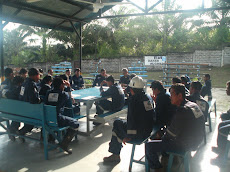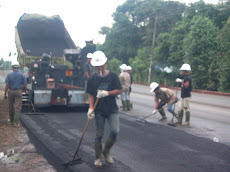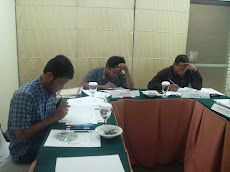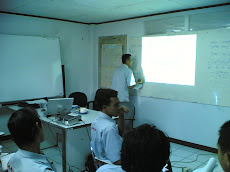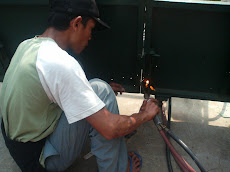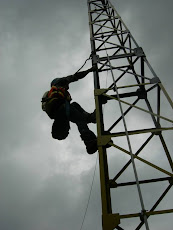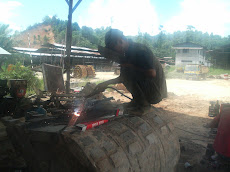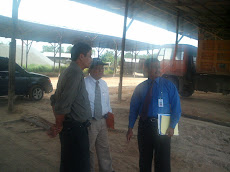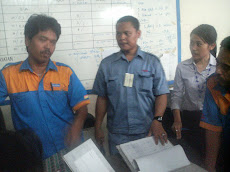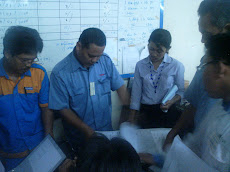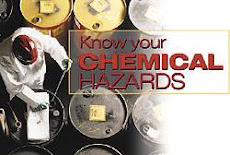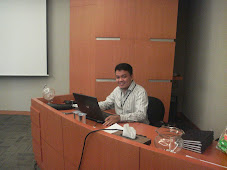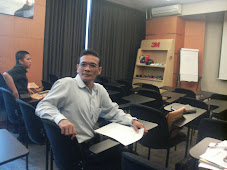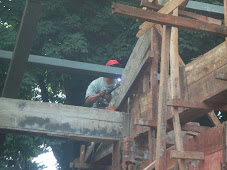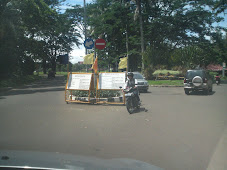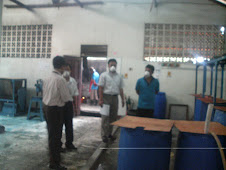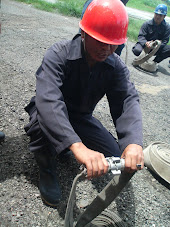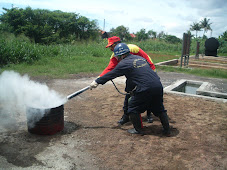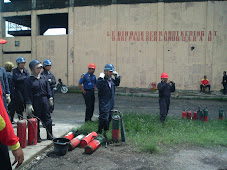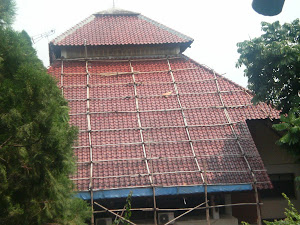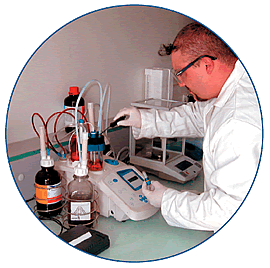
Sabtu, 17 Januari 2009
Risk Management in ISO31000 standard ?
The way people define risk has significant repercussions for the way risks are identified
and the way they are managed. Risk professionals see risk as a combination of the consequences of an
event and the likelihood of an event with those consequences occurring (technical risk). However, as
Sandman has pointed out, society’s view of risk equates with hazard plus outrage (sociological risk).
In other words we concentrate on calculating the risk, identifying the controls in place, determining
the residual risk, and assessing on that basis if we will accept the risk or not. The community’s
response, however, equates to the level of outrage the event produces.
Sustainability, likewise, has many definitions and encompasses anything from social justice issues and
the environment to how an organisation can continue to survive a globally competitive environment.
Of recent times organisations have been looking at triple or quadruple bottom line reporting and have
started identifying sustainability as a risk (both threat and opportunity) they must manage to
increasingly greater levels in the future. The nature of sustainability risk is seen as new and emerging,
different to the risks that organizations and risk managers have traditionally faced, and one that will
require different solutions than those that caused it to become an issue in the first place.
While this may be true it is the contention of this paper that risk and sustainability are two sides of the
one coin and are therefore inextricably linked. One cannot be understood without the other.
A holistic model is put forward that clearly identifies the link and demonstrates how an understanding
of both risk and sustainability will be essential for future decision making
and the way they are managed. Risk professionals see risk as a combination of the consequences of an
event and the likelihood of an event with those consequences occurring (technical risk). However, as
Sandman has pointed out, society’s view of risk equates with hazard plus outrage (sociological risk).
In other words we concentrate on calculating the risk, identifying the controls in place, determining
the residual risk, and assessing on that basis if we will accept the risk or not. The community’s
response, however, equates to the level of outrage the event produces.
Sustainability, likewise, has many definitions and encompasses anything from social justice issues and
the environment to how an organisation can continue to survive a globally competitive environment.
Of recent times organisations have been looking at triple or quadruple bottom line reporting and have
started identifying sustainability as a risk (both threat and opportunity) they must manage to
increasingly greater levels in the future. The nature of sustainability risk is seen as new and emerging,
different to the risks that organizations and risk managers have traditionally faced, and one that will
require different solutions than those that caused it to become an issue in the first place.
While this may be true it is the contention of this paper that risk and sustainability are two sides of the
one coin and are therefore inextricably linked. One cannot be understood without the other.
A holistic model is put forward that clearly identifies the link and demonstrates how an understanding
of both risk and sustainability will be essential for future decision making
Kamis, 15 Januari 2009
البيئة والصحة المهنية والس Azil Awaludinلامة من قبل سعادة
برنامج الماجستير للصحة والسلامة المهنية
أطروحة ، كانون الأول / ديسمبر 2008
Azil Awaludin Suardhy ، NPM. 0706189362
خطأ في التحليل وحقوق المتعاقد من الباطن عامل في قطاع البناء والتشييد على هذا المشروع عام 2008 حزب العمال. باء
س + 103 صفحة ، 8 جداول ، صور 27 ، 5 المرفقات
كما ورد مؤخرا من الحوادث والإصابات في قطاع البناء الحصول على أعداد كبيرة. (وفي عام 2005 والولايات المتحدة حزب العمال Bereau الإحصاءات : سجلت 200000 بجراح خطيرة ، ومبلغ 1200 قتيل كل عام ، وتكوين 7 ٪ من جميع الوفيات يقدم للعامل 21 ٪). مقارنة في اندونيسيا : قطاع البناء والتشييد الحصول على 31،9 ٪ من وقوع الحادث وحادث خلال الفترة من يناير الى أغسطس 2008 : وقوع حوادث يقوم أكثر من 6 مرات وفيات في جاكرتا المقاطعة فقط.
عامل في قطاع البناء تختلف من المديرين العاملين المتعاقدين من الباطن. اسم مثل : المشرف العام ، مدير المشروع ، مدير الموقع ، والمهندس ، فورمان (Mandor) ، والعمال. تصنيف تختلف عن فورمان (mandor) على موقع العامل المقدمة من المتعاقدين من الباطن (البائع). ويختلف مستوى التعليم من المدرسة الابتدائية إلى الثانوية ، فإن العديد من العمال ليست لديها قدرة خاصة على النحو عامل بناء في ما يتعلق بالسلامة والصحة والبيئة.
النمو السريع في مشروع البناء في الوقت الحاضر ، وعلى النحو الذي أوصت به لتعزيز الحكومة في القريب العاجل وسوف تسبب في والسلامة بالنسبة للعامل بناء من الاختصاصات. وخاصة بالنسبة للمقاولين من الباطن وينبغي أن ندرك عامل السلامة في العمل ، والخطر في موقع العمل ، والسلامة وقعت والرموز. الرئيسية المتعاقدين سلامة المنشأة اليومية الإحاطة ، والسلامة إحاطة قصيرة الدوريات. للتغلب على معنى الخطأ البشري على سلامة السلوك على المتعاقدين من الباطن العامل ، بحاجة الى مزيد من الدراسة لتجنب وقوع الحادث وتقليل من الحادث الذي وقع في عامل البناء. هذه الدراسة تستند إلى خطأ بشري. بعد تحليل عامل الأخطاء البشرية القائمة على المعرفة القائمة على الخطأ ، وكانت النتائج الرئيسية الميل إلى العجلة (24،23 ٪) ، والتركيز الانتقائي (20،09 ٪) ، وبغض النظر المتناقضة الأدلة (18،66 ٪).
في خاتمة للدراسة التي عقدت ، والخطأ البشري هو السبب الرئيسي لاختيار تحريك المعرفة القائمة على خطأ. لتجنب هذه الحالة مستمرة وتمنع الخطأ البشري ضرورة أن برنامج الوقاية من الخطأ.
الأدب : 35 (1966 -- 2008)
الكلمات الأساسية : الأخطاء البشرية ، وسلامة السلوك ، والمعرفة القائمة على الخطأ ، والعمال ، للمقاول
أطروحة ، كانون الأول / ديسمبر 2008
Azil Awaludin Suardhy ، NPM. 0706189362
خطأ في التحليل وحقوق المتعاقد من الباطن عامل في قطاع البناء والتشييد على هذا المشروع عام 2008 حزب العمال. باء
س + 103 صفحة ، 8 جداول ، صور 27 ، 5 المرفقات
كما ورد مؤخرا من الحوادث والإصابات في قطاع البناء الحصول على أعداد كبيرة. (وفي عام 2005 والولايات المتحدة حزب العمال Bereau الإحصاءات : سجلت 200000 بجراح خطيرة ، ومبلغ 1200 قتيل كل عام ، وتكوين 7 ٪ من جميع الوفيات يقدم للعامل 21 ٪). مقارنة في اندونيسيا : قطاع البناء والتشييد الحصول على 31،9 ٪ من وقوع الحادث وحادث خلال الفترة من يناير الى أغسطس 2008 : وقوع حوادث يقوم أكثر من 6 مرات وفيات في جاكرتا المقاطعة فقط.
عامل في قطاع البناء تختلف من المديرين العاملين المتعاقدين من الباطن. اسم مثل : المشرف العام ، مدير المشروع ، مدير الموقع ، والمهندس ، فورمان (Mandor) ، والعمال. تصنيف تختلف عن فورمان (mandor) على موقع العامل المقدمة من المتعاقدين من الباطن (البائع). ويختلف مستوى التعليم من المدرسة الابتدائية إلى الثانوية ، فإن العديد من العمال ليست لديها قدرة خاصة على النحو عامل بناء في ما يتعلق بالسلامة والصحة والبيئة.
النمو السريع في مشروع البناء في الوقت الحاضر ، وعلى النحو الذي أوصت به لتعزيز الحكومة في القريب العاجل وسوف تسبب في والسلامة بالنسبة للعامل بناء من الاختصاصات. وخاصة بالنسبة للمقاولين من الباطن وينبغي أن ندرك عامل السلامة في العمل ، والخطر في موقع العمل ، والسلامة وقعت والرموز. الرئيسية المتعاقدين سلامة المنشأة اليومية الإحاطة ، والسلامة إحاطة قصيرة الدوريات. للتغلب على معنى الخطأ البشري على سلامة السلوك على المتعاقدين من الباطن العامل ، بحاجة الى مزيد من الدراسة لتجنب وقوع الحادث وتقليل من الحادث الذي وقع في عامل البناء. هذه الدراسة تستند إلى خطأ بشري. بعد تحليل عامل الأخطاء البشرية القائمة على المعرفة القائمة على الخطأ ، وكانت النتائج الرئيسية الميل إلى العجلة (24،23 ٪) ، والتركيز الانتقائي (20،09 ٪) ، وبغض النظر المتناقضة الأدلة (18،66 ٪).
في خاتمة للدراسة التي عقدت ، والخطأ البشري هو السبب الرئيسي لاختيار تحريك المعرفة القائمة على خطأ. لتجنب هذه الحالة مستمرة وتمنع الخطأ البشري ضرورة أن برنامج الوقاية من الخطأ.
الأدب : 35 (1966 -- 2008)
الكلمات الأساسية : الأخطاء البشرية ، وسلامة السلوك ، والمعرفة القائمة على الخطأ ، والعمال ، للمقاول
Minggu, 11 Januari 2009
Jumat, 09 Januari 2009
Senin, 05 Januari 2009
IWA2 for education institution related to ISO9001
ISO/IWA 2:2007 Project Plan
TASK BREAKDOWN STRUCTURE
1. PROJECT MANAGEMENT
1.1 Project definition
1.2 Project objective and scope
1.3 Project Plan
1.4 Project Management Plan
2. COMMUNICATIONS PLAN
2.1 Internal Communication Plan
2.2 Staff Communication Plan
2.3 Translation of ISO/IWA 2:2007 into Bahasa Indonesia
3. ISO/IWA 2:2007 MONITORING
3.1 Create and maintain a data base of interested parties
3.2 Company monitoring
3.3 Biannual Reports
4. PROJECT TASK GROUP (PTG) MEETINGS
4.1 Revision and restructuring the PTG
4.2 PTG responsibilities and activities
4.3 Intermediate PTG meetings
4.4 Organizing and carrying out the meetings
4.5 Implementation and monitoring of agreements
5. PROMOTIONAL PLAN
5.1 Design and distribution of promotional documents
5.2 Presentations to interested parties
5.3 Organization of national and international events
5.4 Participation in national and international events on education and quality
management in education.
5.5 Collaboration with International Organizations interested in education
6. LIAISON ACTIVITIES
6.1 Collaboration with ISO/TC-176 Liaison Organizations
6.2 Liaison with ISO/TC 176 through the Sector Liaison Forum
6.3 Liaison with Regional Organizations for Standardization
6.4 Liaison with International Organizations dedicated to the accreditation of
educational programs.
7. RESOURCE MANAGEMENT
7.1 Link with funding organizations that finance projects in education
7.2 Presentation of proposals to funding organizations
7.3 Use of resources for performing projects activities
7.4 Reports on quantitative and qualitative results
8. CONTINUOUS ASSESSMENT OF THE IWA 2 PROJECT
8.1 Monitoring the Project Plan
8.2 Project responsible(s) and participants
8.3 Monitoring actions of the IWA 2 Project
9 DECISIONS ON THE TYPE OF ISO STANDARD FOR ISO/IWA 2:2007
9.1 Analysis on the different type of ISO deliverables
9.2 Analysis of education related documents
9.3 Decision on the type of ISO deliverable for the ISO/IWA-2:2007 Guide
9.4 Presentation of the ISO deliverable proposal before a Plenary Meeting
9.5 Activities of the IWA 2 Group in the ISO Technical Committee
Looking at the above-mentioned focus, we can see IWA 2:2003 did not increase in ISO 9001:2000 and change or amend its request, so each of the provisions of ISO 9001:2000 are included in the IWA 2:2003 corresponding text. The text of ISO 9004:2004 are also covered. Continuous performance improvement to enable organizations to provide a complete vision.
In short, IWA 2:2003 still process management in addition to the basic structure and spirit, with special emphasis on laws related to education and the education process based on the design, implementation and performance of the pursuit of continuous improvement and for educational organizations to promote quality management system there its particular value.
To know more or For consultation and training of IWA2 (or IWA1 to IWA5) contact AQD: 06221 70652998
TASK BREAKDOWN STRUCTURE
1. PROJECT MANAGEMENT
1.1 Project definition
1.2 Project objective and scope
1.3 Project Plan
1.4 Project Management Plan
2. COMMUNICATIONS PLAN
2.1 Internal Communication Plan
2.2 Staff Communication Plan
2.3 Translation of ISO/IWA 2:2007 into Bahasa Indonesia
3. ISO/IWA 2:2007 MONITORING
3.1 Create and maintain a data base of interested parties
3.2 Company monitoring
3.3 Biannual Reports
4. PROJECT TASK GROUP (PTG) MEETINGS
4.1 Revision and restructuring the PTG
4.2 PTG responsibilities and activities
4.3 Intermediate PTG meetings
4.4 Organizing and carrying out the meetings
4.5 Implementation and monitoring of agreements
5. PROMOTIONAL PLAN
5.1 Design and distribution of promotional documents
5.2 Presentations to interested parties
5.3 Organization of national and international events
5.4 Participation in national and international events on education and quality
management in education.
5.5 Collaboration with International Organizations interested in education
6. LIAISON ACTIVITIES
6.1 Collaboration with ISO/TC-176 Liaison Organizations
6.2 Liaison with ISO/TC 176 through the Sector Liaison Forum
6.3 Liaison with Regional Organizations for Standardization
6.4 Liaison with International Organizations dedicated to the accreditation of
educational programs.
7. RESOURCE MANAGEMENT
7.1 Link with funding organizations that finance projects in education
7.2 Presentation of proposals to funding organizations
7.3 Use of resources for performing projects activities
7.4 Reports on quantitative and qualitative results
8. CONTINUOUS ASSESSMENT OF THE IWA 2 PROJECT
8.1 Monitoring the Project Plan
8.2 Project responsible(s) and participants
8.3 Monitoring actions of the IWA 2 Project
9 DECISIONS ON THE TYPE OF ISO STANDARD FOR ISO/IWA 2:2007
9.1 Analysis on the different type of ISO deliverables
9.2 Analysis of education related documents
9.3 Decision on the type of ISO deliverable for the ISO/IWA-2:2007 Guide
9.4 Presentation of the ISO deliverable proposal before a Plenary Meeting
9.5 Activities of the IWA 2 Group in the ISO Technical Committee
Looking at the above-mentioned focus, we can see IWA 2:2003 did not increase in ISO 9001:2000 and change or amend its request, so each of the provisions of ISO 9001:2000 are included in the IWA 2:2003 corresponding text. The text of ISO 9004:2004 are also covered. Continuous performance improvement to enable organizations to provide a complete vision.
In short, IWA 2:2003 still process management in addition to the basic structure and spirit, with special emphasis on laws related to education and the education process based on the design, implementation and performance of the pursuit of continuous improvement and for educational organizations to promote quality management system there its particular value.
To know more or For consultation and training of IWA2 (or IWA1 to IWA5) contact AQD: 06221 70652998
Langganan:
Postingan (Atom)





